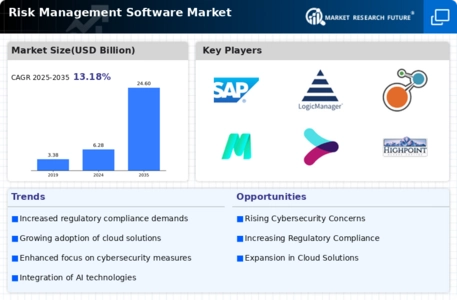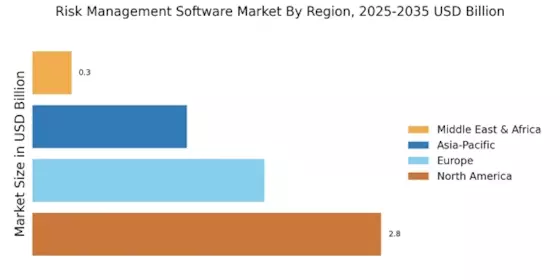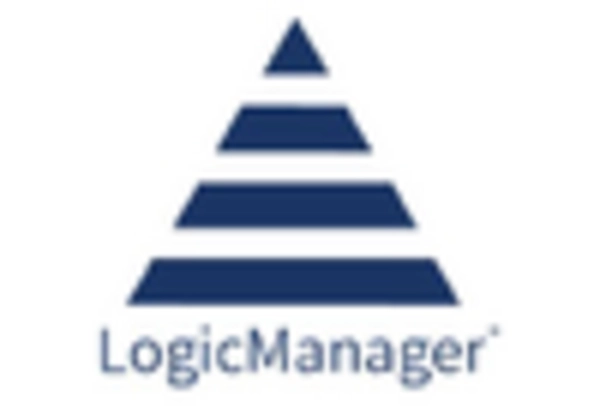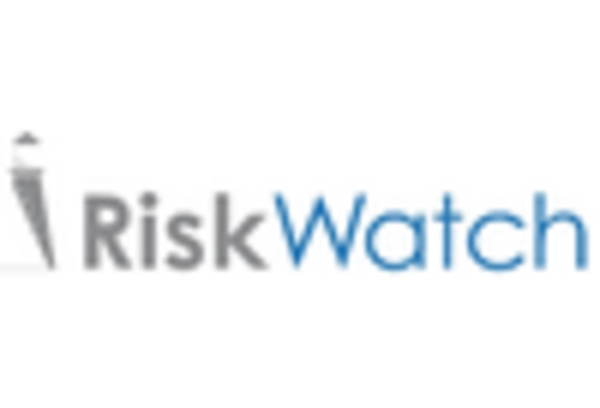The Risk Management Software Market is currently characterized by a dynamic competitive landscape, driven by the increasing need for organizations to mitigate risks associated with regulatory compliance, cybersecurity threats, and operational inefficiencies. Key players such as IBM (US), SAP (DE), and Oracle (US) are at the forefront, leveraging their technological prowess to enhance their offerings. IBM (US) focuses on integrating artificial intelligence into its risk management solutions, thereby enabling predictive analytics that can preemptively identify potential risks. Meanwhile, SAP (DE) emphasizes its cloud-based solutions, which facilitate real-time risk assessment and management, appealing to organizations seeking agility in their operations. Oracle (US) is strategically positioned through its comprehensive suite of enterprise applications, which allows for seamless integration of risk management functionalities across various business processes. Collectively, these strategies not only enhance their competitive positioning but also contribute to a more sophisticated market environment.
In terms of business tactics, companies are increasingly localizing their operations to better serve regional markets, optimizing supply chains to enhance efficiency, and investing in digital transformation initiatives. The Risk Management Software Market appears moderately fragmented, with a mix of established players and emerging startups. This fragmentation allows for diverse offerings, yet the collective influence of major players like IBM (US) and SAP (DE) tends to set industry standards, shaping customer expectations and driving innovation.
In August 2025, IBM (US) announced the launch of its new AI-driven risk management platform, which aims to provide organizations with enhanced predictive capabilities. This strategic move is significant as it positions IBM (US) as a leader in leveraging advanced technologies to address complex risk scenarios, potentially attracting a broader client base seeking cutting-edge solutions. The integration of AI not only enhances the functionality of risk management tools but also aligns with the growing trend of digital transformation across industries.
In September 2025, SAP (DE) expanded its partnership with a leading cybersecurity firm to bolster its risk management offerings. This collaboration is crucial as it enhances SAP's ability to provide comprehensive solutions that address both operational and cybersecurity risks. By integrating specialized cybersecurity measures into its risk management software, SAP (DE) demonstrates a proactive approach to evolving threats, thereby reinforcing its market position and appealing to organizations prioritizing security.
In July 2025, Oracle (US) unveiled a new feature within its risk management suite that automates compliance reporting. This development is particularly relevant as it addresses the increasing regulatory pressures faced by organizations globally. By streamlining compliance processes, Oracle (US) not only enhances operational efficiency for its clients but also solidifies its reputation as a comprehensive provider of risk management solutions, catering to the needs of businesses navigating complex regulatory landscapes.
As of October 2025, the competitive trends within the Risk Management Software Market are increasingly defined by digitalization, sustainability, and the integration of artificial intelligence. Strategic alliances, such as those seen between SAP (DE) and cybersecurity firms, are shaping the landscape by fostering innovation and enhancing product offerings. Looking ahead, it is likely that competitive differentiation will evolve, with a pronounced shift from price-based competition to a focus on innovation, technological advancement, and supply chain reliability. This evolution suggests that companies that prioritize these aspects will be better positioned to thrive in an increasingly complex and risk-laden business environment.


















Leave a Comment